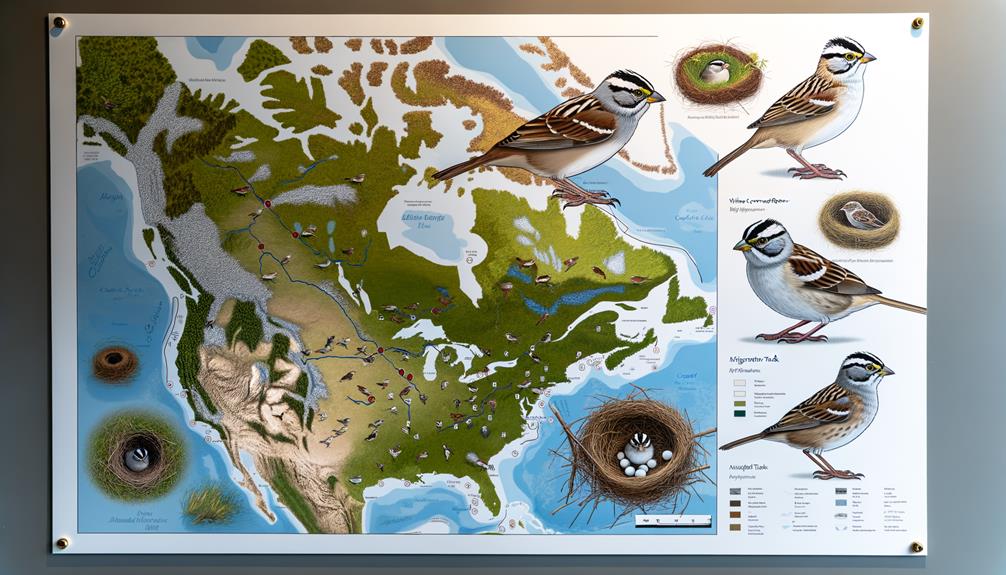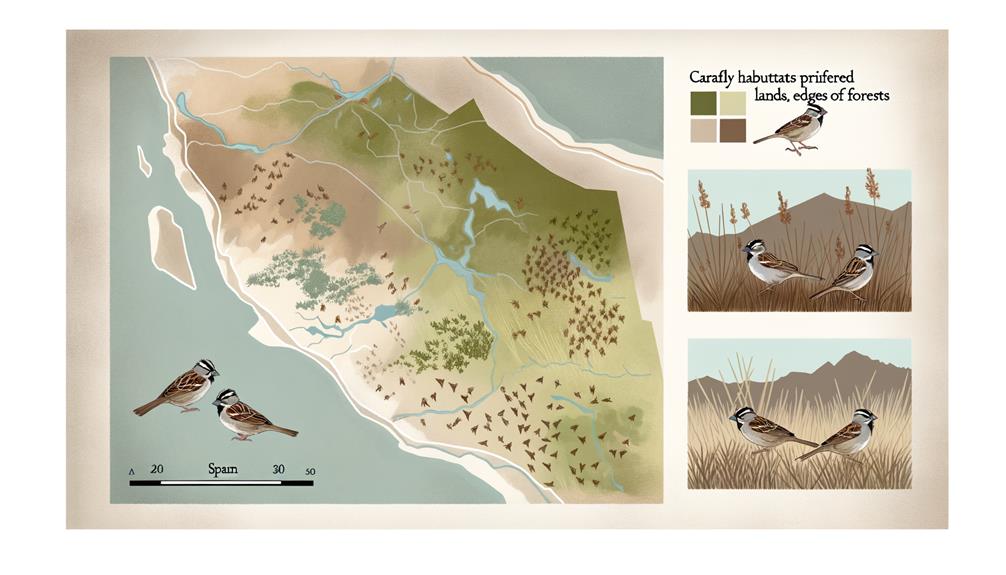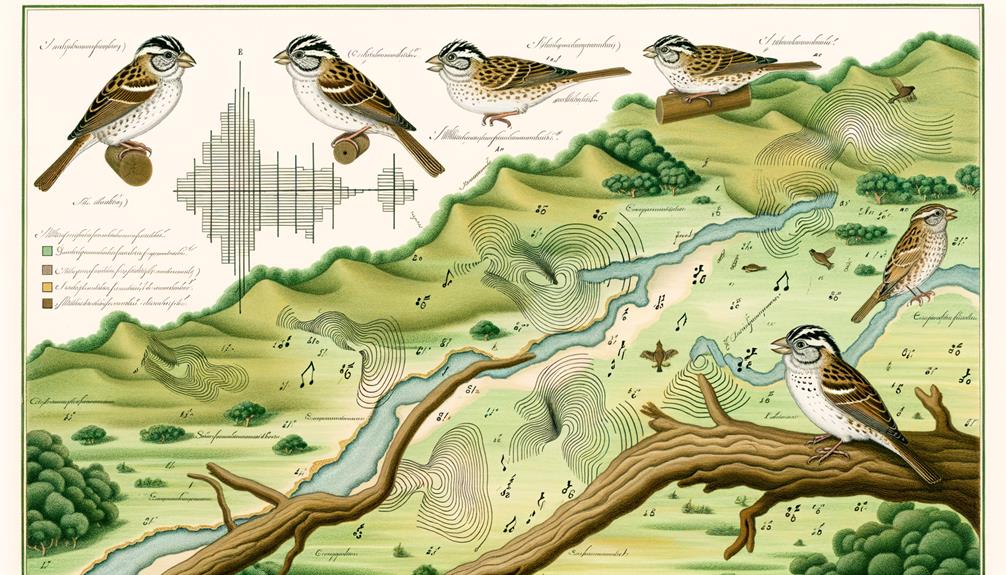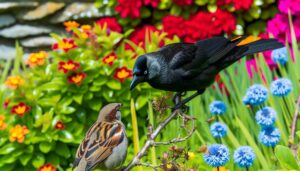Key Areas on the Field Guide Map of White-Crowned Sparrow
The White-crowned Sparrow, recognizable by its distinctive black and white head stripes, is found across various North American regions. These sparrows inhabit dense shrubs, open meadows, and wooded edges.
During breeding, they occupy northern areas and migrate to southern US and Central America in winter. Their robust, medium-sized bodies and conical bills are adapted for seed consumption and ground foraging.
They employ vocalizations for territory establishment and mate attraction, featuring clear whistles and trills. Juveniles display muted head markings compared to adults.
Understanding their habitat preferences and migratory patterns reveals deeper insights into their ecological adaptation strategies.

Key Takeaways
- The White-crowned Sparrow migrates between northern breeding grounds and southern US to Central America wintering grounds.
- Key wintering habitats include meadows, thickets, suburban gardens, wooded edges, and wetlands.
- Breeding habitats feature dense shrubs and low vegetation for nesting.
- Migration routes and wintering locations show the sparrow's adaptability to diverse ecosystems.
- Regional dialects in their songs can vary geographically, reflecting their migratory patterns.
Species Overview

Why does the White-crowned Sparrow, scientifically known as *Zonotrichia leucophrys*, exhibit such distinctive black and white head markings? These markings serve as critical identifiers in social and territorial interactions.
Researchers have observed that these bold patterns help the species recognize and communicate with conspecifics. During the breeding season, the striking head markings play a pivotal role in mate selection and dominance displays.
Territorial males often use these visual signals to assert dominance and deter rivals. The markings also aid in the recognition of individual birds within flocks, facilitating social cohesion.
Through methodical field studies, ornithologists have documented these behaviors, underscoring the importance of visual cues in the life history of *Zonotrichia leucophrys*. This adaptability showcases their evolutionary success.
Physical Characteristics
The White-crowned Sparrow exhibits distinctive head stripes, characterized by bold black and white markings.
It possesses a medium-sized, robust body with a conical bill, optimized for seed consumption.
The plumage showcases a combination of gray and brown hues, with striking white and black patterns on the head.
Distinctive Head Stripes
Distinctive head stripes on the White Crowned Sparrow consist of bold black and white patterns that provide a clear visual identification marker among bird species.
The alternating black and white stripes start from the bill's base, extending over the crown and terminating at the nape. The median crown stripe is white, flanked by two symmetrical black stripes, with outer white superciliary stripes above the eyes.
This pattern is more pronounced in adults, providing an easily recognizable feature for ornithologists. Juveniles display a more muted version, with brown and gray tones replacing the stark black and white.
These head stripes serve not only for species identification but also play a role in social signaling and mate selection, underlining their ecological significance.
Size and Shape
Adult White Crowned Sparrows exhibit a medium-sized, robust body structure with a length ranging from 15 to 17 centimeters and a wingspan of approximately 23 to 25 centimeters. The species presents a plump and rounded physique, optimized for agile foraging and swift flight.
Its tail is relatively short and notched, contributing to maneuverability in dense shrubbery. The beak, conical and stout, is perfectly adapted for seed-cracking, a primary dietary habit. Legs are sturdy, providing stability and support during ground foraging.
The overall morphology indicates a bird well-suited for varied habitats, from coastal areas to mountainous regions. Observers will note the sparrow's compact yet substantial form, reflecting its evolutionary adaptations for survival and resource acquisition.
Plumage Coloration
Upon close observation, one notices that the White Crowned Sparrow's plumage features striking black-and-white striped crowns, which are particularly prominent during the breeding season. The adult's head presents a bold contrast, with black stripes framing the white central stripe. Juveniles, however, display a more subdued brown-and-tan pattern. Their back and wings exhibit a mix of brown and gray feathers, providing effective camouflage in their natural habitat.
| Plumage Area | Adult (Breeding) | Juvenile |
|---|---|---|
| Crown | Black-and-white stripes | Brown-and-tan stripes |
| Back | Brown with gray streaks | Brown with gray streaks |
| Wings | Brown and gray | Brown and gray |
| Throat | White | Buff |
| Underparts | Gray | Buff |
Such coloration aids in species identification and understanding their ecological roles.
Habitat Preferences

The White Crowned Sparrow exhibits distinct habitat preferences, particularly evident in its breeding and wintering behaviors. During the breeding season, it selects shrubby, open areas at higher elevations, which provide ideal conditions for nesting.
In contrast, its winter migration patterns reveal a preference for lower elevations and coastal regions, where food resources are more abundant.
Breeding Grounds Locations
White-crowned sparrows exhibit a strong preference for breeding in open habitats with dense shrubbery, such as alpine meadows, coastal sage scrub, and tundra regions. They select areas that provide ample cover and nesting materials, essential for protection against predators.
Observational data indicate a significant inclination towards elevations ranging from sea level to 3,000 meters, depending on geographic location. These birds often establish territories near water sources, securing a steady supply of food. They favor environments where vegetation structure supports their nesting requirements—typically low shrubs and grasses interspersed with open ground.
During breeding season, the sparrows' territorial behavior intensifies, with males actively defending chosen sites. This methodical selection process ensures ideal conditions for raising their young, offering both safety and sustenance.
Winter Migration Patterns
During winter migration, these sparrows exhibit a marked preference for habitats that offer dense cover and abundant food sources. They frequent brushy fields, shrubby areas, and forest edges, where they can find seeds, insects, and berries.
Observations indicate they favor areas with a mix of open ground for foraging and dense vegetation for protection from predators. They also show adaptability by utilizing human-altered landscapes like gardens and parks, provided these areas meet their habitat criteria.
Monitoring efforts have recorded their presence in regions ranging from the southern United States to northern Mexico. The sparrows' selection of diverse habitats underscores their ecological flexibility and aids in their survival during the harsh winter months, ensuring they remain resilient and resourceful.
Regional Populations
Across North America, regional populations of the White-crowned Sparrow exhibit distinct variations in plumage, song patterns, and migratory behaviors. Eastern populations display darker lores and more contrasting plumage compared to their western counterparts. Importantly, the Nuttall's subspecies, found in coastal California, has a unique song characterized by a higher frequency of trills.
In contrast, the Gambel's subspecies, prevalent in Alaska and northern Canada, features a simpler, more repetitive song structure. These variations aren't merely aesthetic; they play critical roles in mate selection and territorial defense. Researchers have meticulously documented these differences through field observations and audio recordings, creating detailed profiles for each regional population.
This detailed understanding underscores the adaptability and evolutionary diversity of the White-crowned Sparrow.
Migration Patterns

Although regional populations exhibit distinct characteristics, migration patterns of the White-crowned Sparrow reveal consistent long-distance journeys that span thousands of kilometers between breeding and wintering grounds. They undertake biannual migrations with remarkable punctuality, often utilizing established flyways.
During spring, they travel northward to breeding territories in Alaska and Canada. Come autumn, they head south to wintering areas in the United States and Mexico. Observations indicate that juveniles exhibit innate migratory routes, suggesting strong genetic influences. These migratory paths are influenced by environmental cues such as daylight length and temperature changes.
The sparrows rely on stopover sites to rest and refuel, demonstrating a keen ability to navigate and adapt to dynamic landscapes, ensuring their survival and reproductive success.
Breeding Season
During the breeding season, White Crowned Sparrows exhibit specific mating rituals that include song displays and territorial behaviors.
They prefer nesting habitats characterized by dense shrubs and low vegetation, providing both concealment and access to food sources.
Observing these patterns aids in understanding their reproductive success and habitat selection.
Mating Rituals Observed
Observations reveal that male White Crowned Sparrows engage in a series of elaborate vocalizations and physical displays to attract mates during the breeding season.
Males initiate courtship by singing complex, melodious songs that serve both to establish territory and to entice females. These vocalizations are characterized by distinct regional dialects, indicating local adaptation.
In addition to auditory displays, males also perform a series of visual gestures, including puffing up their plumage and executing short, fluttering flights. These behaviors are meticulously timed to coincide with the arrival of females in the breeding area.
Females, in turn, evaluate these displays critically, selecting mates based on the quality and consistency of their performances. This ritual is essential for successful pairing and subsequent reproduction.
Nesting Habitat Preferences
White Crowned Sparrows exhibit a strong preference for nesting in dense shrubbery or low vegetation, which provides both concealment from predators and proximity to abundant food sources. These birds often select habitats featuring thick brush, young pine forests, or areas with ample ground cover.
Their nests, typically constructed from grasses, twigs, and moss, are well-hidden within the foliage. Observations indicate that they opt for locations with minimal human disturbance, ensuring a secure environment for raising their young. The choice of nesting sites also correlates with the availability of insects, seeds, and berries, essential for chick development.
Wintering Grounds

As temperatures drop, the White Crowned Sparrow instinctively migrates to its wintering grounds, which span from the southern United States to parts of Central America. These avian travelers display remarkable adaptability to diverse habitats during their winter sojourn.
Researchers have noted key areas where these sparrows congregate, showcasing their resilience and survival instincts.
- Scenic meadows: Offering vast open spaces for foraging.
- Dense thickets: Providing essential shelter from predators.
- Suburban gardens: Illustrating their adaptability to human-altered landscapes.
- Wooded edges: Combining cover and feeding opportunities.
- Wetlands: Ensuring access to water and unique food sources.
Each location reflects the sparrow's capacity to thrive across varied ecosystems, underscoring their remarkable migratory journey. This adaptability highlights the sparrow's intrinsic drive for freedom and survival.
Feeding Habits
In their wintering grounds, White Crowned Sparrows exhibit a diverse array of feeding habits tailored to the availability of local resources. They primarily consume seeds, insects, and fruits, demonstrating adaptive foraging strategies. These birds often forage on the ground, utilizing their keen eyesight to detect food.
| Resource Type | Feeding Behavior |
|---|---|
| Seeds | Ground foraging, pecking at soil surfaces to extract seeds. |
| Insects | Active pursuit, capturing insects mid-air or from vegetation. |
| Fruits | Selective plucking, targeting berries and small fruits from shrubs. |
Their diet shifts with seasonal changes, ensuring a stable intake of nutrients. Observation reveals a preference for areas with abundant seed sources during colder months, highlighting their adaptability and resourcefulness in varying environments.
Vocalizations

Renowned for their distinct and complex songs, White Crowned Sparrows produce vocalizations that play essential roles in territory establishment and mate attraction. Males typically sing from exposed perches, employing a series of clear whistles followed by buzzy trills. These songs vary geographically, reflecting regional dialects that can be vital for individual recognition.
Juveniles learn their songs by listening to adult conspecifics, demonstrating an important period for song acquisition.
- The melodic purity of their whistles can evoke a sense of peace.
- Trills often signal a strong assertion of territorial dominance.
- Regional song variations highlight the sparrows' adaptability.
- The intricate learning process underscores their cognitive sophistication.
- Calls during flight can evoke a sense of wild freedom.
Their vocal repertoire reflects both innate and learned components, embodying avian acoustic diversity.
Observation Tips
To effectively observe White Crowned Sparrows, one should focus on early morning hours when these birds are most active. Observers should equip themselves with binoculars and a reliable field guide for accurate identification.
These sparrows frequent open woodlands, shrubby areas, and grasslands, often foraging on the ground for seeds and insects. Patience is essential; staying quiet and minimizing movement increases the likelihood of close encounters. Documenting observations with notes or photographs can enhance future identification skills.
Additionally, listening for their distinctive, clear whistles aids in locating them. Weather conditions also play a critical role, with calm, clear mornings providing the best visibility. By following these tips, one can enjoy a rewarding birdwatching experience.
Conservation Status

The White Crowned Sparrow's conservation status is currently classified as 'Least Concern' by the International Union for Conservation of Nature (IUCN), indicating a stable population trend across its range. This classification reflects the species' resilience and adaptability to diverse habitats, from tundra to forest edges. Despite facing habitat loss and climate change, the White Crowned Sparrow remains robust.
Populations are widespread and abundant.
They exhibit high reproductive success.
Habitat versatility secures their survival.
Migratory patterns adjust to environmental changes.
Conservation measures continue to support their habitats.
These factors collectively contribute to their thriving numbers, suggesting that immediate conservation actions aren't critical. However, ongoing monitoring is essential to guarantee that this status remains unchanged, safeguarding the species' future.
Interesting Facts
Often observed in diverse habitats, the White Crowned Sparrow displays a striking black and white striped head, which aids in its identification and study by ornithologists.
This bird exhibits remarkable adaptability, thriving in environments ranging from tundra to urban gardens. Its diet, primarily composed of seeds and insects, shifts seasonally, showcasing its opportunistic feeding behavior.
During migration, these sparrows can cover extensive distances, sometimes exceeding 2,600 miles. Their vocalizations are complex and regionally distinct, serving as a focal point for research on avian communication.
Intriguingly, juveniles undergo a protracted molt, evolving into their iconic adult plumage. Observing this species offers invaluable insights into avian ecology, migration patterns, and adaptive strategies in fluctuating environments.
Conclusion
To sum up, the White-crowned Sparrow, nature's wandering bird, impresses us with its flawless migration routes and unique vocalizations. Its habitat preferences are as diverse as a teenager's music preferences, and its physical traits could make many bird enthusiasts jealous.
As you venture out with your binoculars, keep in mind: safeguarding their habitats guarantees these singing marvels don't fade into mere memories. Isn't it about time we prioritized their preservation as much as their melodic performances?






